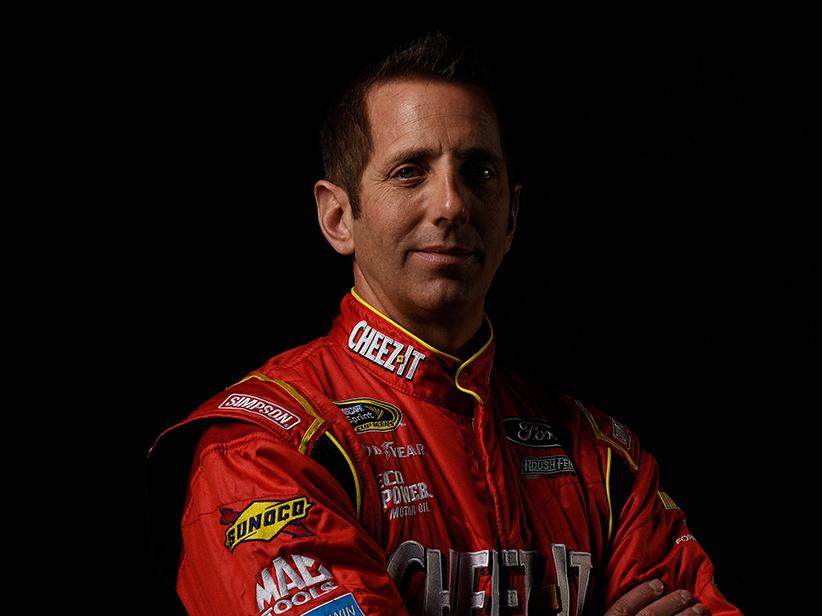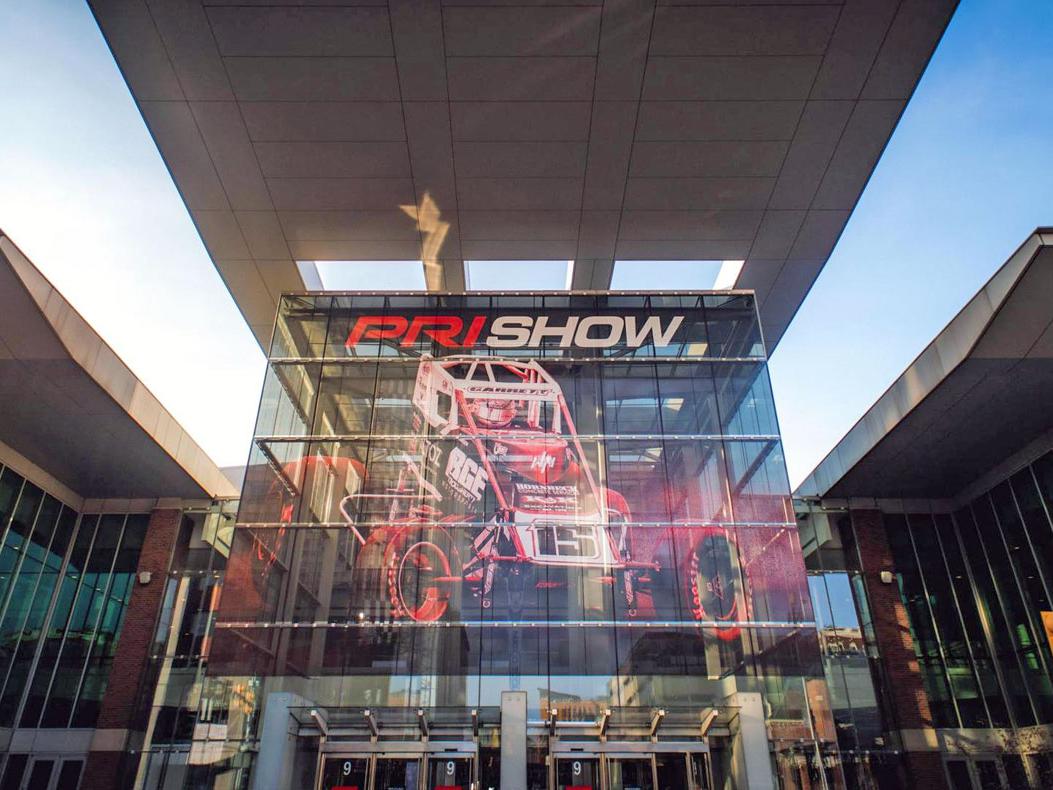Behind-the-Scenes: May in Indianapolis -- Part 1

PRI Associate Editor A.J. Hecht attended various racing events in and around Indianapolis throughout the month in the lead-up to the 108th Indianapolis 500. Read some of his thoughts and observations below:
There is really nothing like May in Indianapolis. The race breathes life into the entire city. The trees bloom, the sun shines, the city bustles and thousands of people descend on the Crossroads of America to witness the largest single-day sporting event in the world.
Naptown? Not this month.
Everywhere you look, there's a checkered flag. Dangling from balconies, mounted on flag poles, stuck in carefully maintained flowerbeds dotting the Circle City.
And it's not just about what's going on at the Brickyard.
In Anderson, the sprint car world gathered for the Little 500. In Winchester, the USAC Silver Crown circus competed for the Rich Vogler Classic, then moved on to Brownsburg for the modern-day Hoosier Hundred. Up in Kokomo, the High Limit Series made its first-ever visit. Meanwhile, late models and wingless sprints lit it up in Bloomington.
It's a magical month if you're a Hoosier. It's heaven if you love racing.
Friday, May 10 -- Sonsio Grand Prix Practice and Qualifying
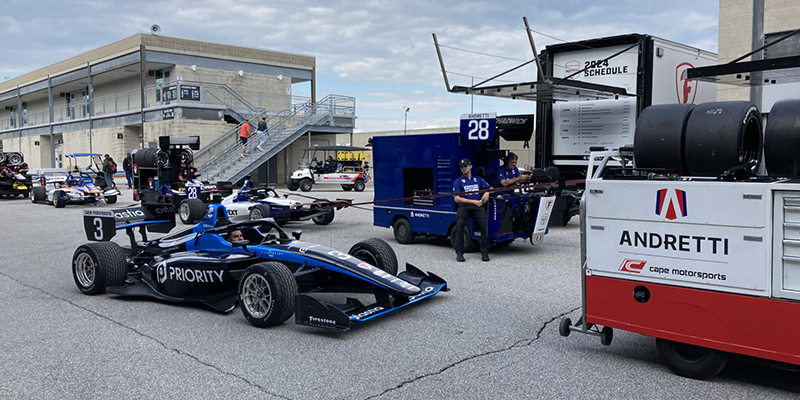
I was fortunate enough to attend a testing day in April ahead of the Sonsio Grand Prix, the NTT INDYCAR SERIES event that serves as the opening for the "Month of May" at Indianapolis Motor Speedway (IMS). That day, the speedway was relatively empty. That was not the case on Friday.
Pit lane, of course, was bustling, filled to the brim with tires, spare wings, coolers, crew members, and scores of onlookers, snapping photos of their favorite drivers. The Pagoda Plaza, a prime gathering spot for fans wandering the gigantic facility, was humming with activity, smelling like fried food and gasoline. The biggest difference, however, was the presence of the famed "Yellow Shirts," the intrepid crew of security, crowd control, and do-it-all-ers for IMS. Their whistles are ubiquitous here, especially as you approach Gasoline Alley, halting fans and allowing, cars, crew, and tuggers and dollies stacked with Firestones to and from pit lane.
The action wasn't confined to pit lane. Behind the suites, the INDY NXT squads geared up for a practice session of their own, firing up engines, pulling their spec IL-15 Dallaras out of the garage before heading out on track.
The media center, too, was filled with life. Writers and photographers, radio and television personnel, PR and marketing staff, all plugging away on their computers to meet deadlines, update their Twitter followers or fire off emails.
A steady stream of on-track action meant a continuous hum of background noise, with USF Pro 2000 and USF 2000 supplementing the soundtrack for the opening weekend of May. Music to my ears.
Saturday, May 11 -- Sonsio Grand Prix
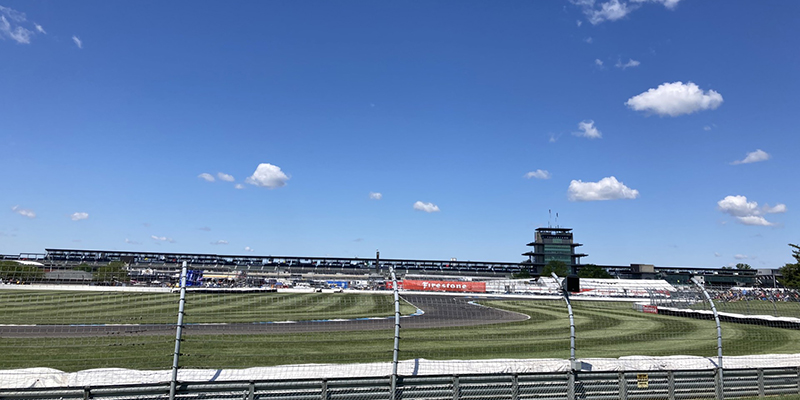
For many, the "Month of May" is about traditions. There are race traditions: 11 rows of three, a cold glass of milk, "Back Home Again in Indiana," etc. You likely know most of them. Fans also have traditions of their own: a morning tailgate, drawing names for the family pool, collecting pins, whatever it is that makes the day special. Some have been going on for years, decades even. Others are new. After all, traditions have to start somewhere.
The Sonsio Grand Prix is a new tradition for my family. We attended our first "Grand Prix" in 2023. With one under our belt, we knew what to expect and claimed a spot on a viewing mound at the end of the backstretch. In the middle of the quick left-right-left that is Turns Seven, Eight, and Nine, we saw plenty of action, including a staggering number of passes for position and frequent four-wheel slides from cars running on the absolute limit.
Seeing an Indy car driven at that speed and intensity gives you an appreciation for not only the performance but the durability of the car and its parts. As they approach the hard left at Turn Seven, the engine is at full song. In a matter of moments, the driver slams on the brakes, now glowing red, and clicks down through the gears, then throws the car into the corner, tires screaming and spinning as they jump back on the throttle. Imagine the heat generated, the stress on the tires, the shifting weight load on every corner of the car, pushing the suspension, the gearbox, the brakes, the engine, to the knife's edge. These cars are modern marvels.
IMS was built in 1909 as a place to test the early automobile. It's sometimes easy to forget that a modern-day Indy car is the result of that 115 years of history, but to this very day, the Speedway is living up to that original mission as the motorsports industry pushes the boundaries of what's possible.
Tuesday, May 14 -- Opening Day of Indianapolis 500 Practice
No "Month of May" is complete without a washout, although the day wasn't completely lost. Drivers, including NASCAR star Kyle Larson, were able to get some limited track time, but green-flag conditions lasted just 23 minutes. That was enough track time, however, for Scott Dixon to lay down a blistering lap of 229.107 mph, and Marco Andretti to dust off the cobwebs with a lap above 228 mph.
Wednesday, May 15 -- Indianapolis 500 Practice
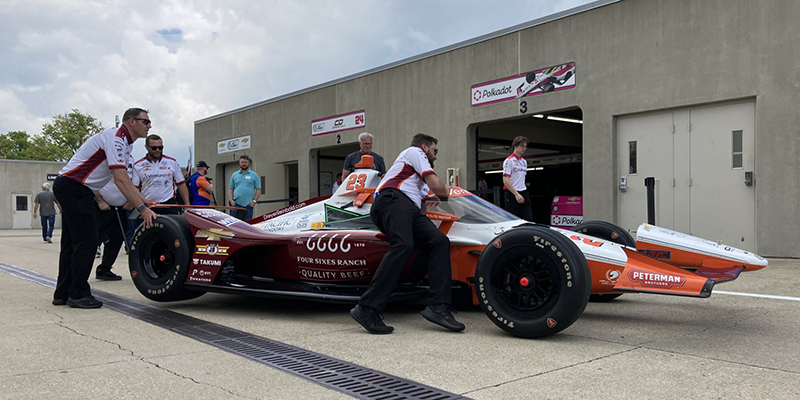
Wednesday didn't look too much different from Tuesday, but there was some on-track activity in the morning. Unfortunately, there were no Indy cars, just jet dryers, street sweepers, and a fleet of Silverados, racking up laps in a futile attempt to dry the soaked pavement. It's a familiar sight for any veteran INDYCAR fan.
Luckily, the sun came out, the track dried up and we got to see some cars on track in the afternoon. With the green flag flying at 3 p.m., it was a mad dash to make up for lost time. Within the first hour, 33 of the 34 entries had completed at least one lap, and Scott McLaughlin picked up right where his countryman left off on Tuesday with a lap just north of 229 mph, the fastest of the day.
Meanwhile, the rest of the speedway came to life. Fans packed the sections of open grandstand and dotted the viewing mounds in the infield. After almost two days of rain, it was nice to see some of the fervor and energy that we've all come to expect from IMS.
Thursday, May 16 -- Indianapolis 500 Practice
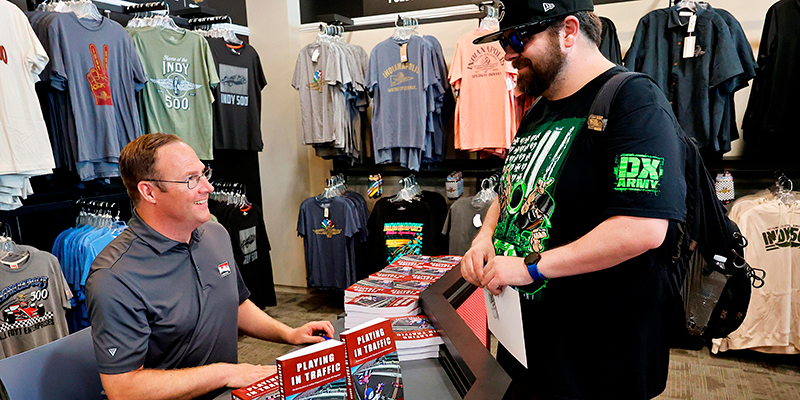
Aaron Likens (left). Image Courtesy of IMS/INDYCAR.
A clear forecast meant lots of action as teams made up for lost time, not only from the previous two rain-soaked days but also a lost day during the April open test. Colton Herta threw down the gauntlet early with a blistering 224-mph lap without a tow, the speed chart to keep an eye on for a preview of likely pole favorites.
The flag stand, which sits directly above the Yard of Bricks, was missing its usual occupant for the start of practice, as Aaron Likens, the chief starter for the series, celebrated the release of his new book, Playing in Traffic. Likens, who was diagnosed on the Autism spectrum in 2003, has carved out a spot for himself in the paddock and describes what it took to get there.
Starting out flagging club races in St. Louis, Likens worked his way up through the ranks and credits his passion for racing as the driving force behind his career in motorsports.
It's something he picked up on after watching Mario Andretti flag a quarter-midget race in Phoenix earlier in his career, he said. Andretti, who was the honorary starter for the event, wanted to stick around the flagstand for the rest of the race.
"You're not going to say no to Mario," Likens said.
Throughout the heat, Andretti was totally invested in the race, Likens told me, pointing out comers and goers, critiquing lines, and calling out passes before they happened.
"You can be passionate about something, but to have it in your soul to where you live and breathe it, people pick up on that."
Now an integral part of the series, Likens says it's a dream come true to be able to flag the Indianapolis 500.
"I came here as a spectator 20-plus times and to now be on the other side of the fence, to be a part of it," he said, "I probably didn't do it justice in the book just what that feels like."
On track, the day took an unfortunate turn for two drivers: Linus Lundqvist, the Swedish Chip Ganassi Racing driver attempting to make his first 500, and Marcus Ericsson, the 2022 winner and last year's runner-up. Both put their Honda-powered Dallaras in the wall, with Lundqvist tagging the Turn Two SAFER Barrier and Ericsson absorbing several hard hits against the Turn Four retaining and inside walls before bouncing off the pit wall attenuator.
Any wreck during Indianapolis 500 practice is a major setback, no matter what team takes the brunt of the impact. Chassis are regularly written off due to hard hits at the Speedway, and a car that has spent months in the shop in preparation for the "Greatest Spectacle in Racing," can be lost in an instant.
After Ericsson's incident, the recovery team brought the heavily damaged car back to the Andretti Global garage for assessment. By the end of the day, the 28 team was preparing the backup car.
Friday, May 17 – Indianapolis 500 Practice – Fast Friday
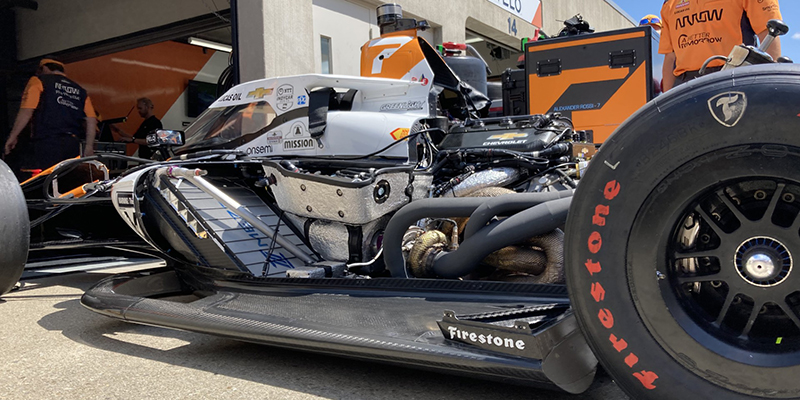
Pulling into the parking lot felt a little bit different on Friday morning. As I mentioned before, the speedway has a very different feel when people start to fill the grandstands, even more so on Fast Friday, when INDYCAR turns up the turbo boost and the speeds flirt with the low 240s at the end of the straightaways. Thanks to some offseason weight reduction, some were positing that the long-standing track record, set by Arie Luyendyk in 1996, could be in jeopardy. That speculation added to the already infectious buzz of the speedway after emerging from several days of stifling rain.
Unfortunately, the day was marred by a crash from rookie Nolan Siegel, who lost it in Turn Two and ended up on his lid. He was okay, but the car was not.
The rest of the day was incident-free, with teams gauging their true speed and pole potential on four-lap "qualy sims," making repeated trips from pit lane to Gasoline Alley and back, looking for tenths, hundredths of a mile per hour, whatever they could find.
Back in the garages, teams stripped down their cars to the bare bones, cooling engines and tweaking setups, while Firestone, INDYCAR's exclusive tire provider, continued its herculean effort to supply the 34 entries with fresh rubber.
On Friday, I had the pleasure of speaking with Cara Krstolic, executive director of race tire engineering and production for Firestone, and Mark Williamson, the service crew manager, who is tasked with leading the team--18 techs strong--as they mount and balance tires for each team.
Thanks to the expanded grid and extensive track time available to the entry list, Firestone goes through 5,000 tires during the "Month of May," almost five times the number of slicks used over the course of a typical INDYCAR race weekend.
It was an enlightening conversation, and Pat Caporali, the PR rep for Firestone, pointed out a small piece of information that is representative of the level of detail surrounding the entire operation. If you have a sharp eye, you'll notice that some of the Firehawks are marked with red Firestone "F" badges. Others have a white badge. The difference? Red is for right-side tires. White is for left-side tires.
I wrote up a more extensive account of our conversation, so if you'd like to hear about the operation in a little more detail, check that out here.
Saturday, May 18 – Indianapolis 500 Qualifying – Day 1
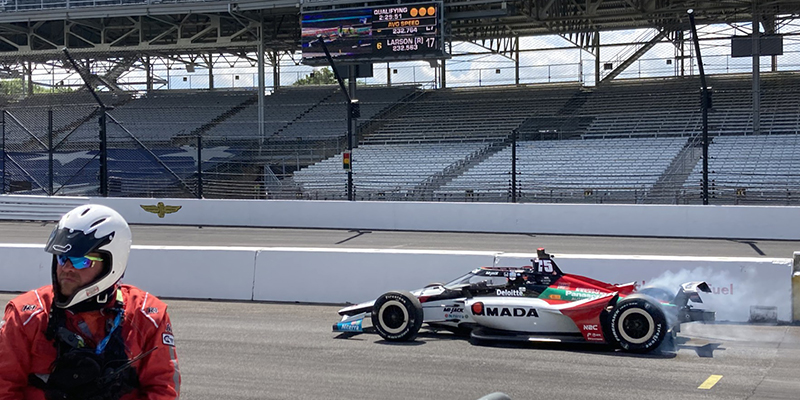
If you've spent any time in the paddock or followed INDYCAR for a while, you know that the four laps it takes to qualify for the Indianapolis 500 are among the most stressful, on-edge laps a driver will ever run. Just ask Rinus Veekay.
Only 23, the young Dutchman has already competed in four 500s and never started worse than fourth. But on Saturday, during the fourth run of the day, Veekay's car snapped loose on the exit of Turn Three and ended up on the hook of a Stepp's Race Recovery tow truck.
Back in the garage, Ed Carpenter Racing feverishly pieced the car back together, and, before long, got him back on track to secure his place in the show.
Although it didn't quite reach his usual front-row potential, the 2021 GMR Grand Prix winner put it into the field, 29th on the scoring pylon. But, as it turns out, that wasn't the end of the ECR driver's day.
Any reasonable person would advise against pulling your car out of the Indianapolis 500, even if it means starting a few rows further up, but that doesn't mean it doesn't happen. On Saturday, Veekay and his team made the call to withdraw their time and jump the lengthy line of cars waiting for one more shot at a four-lap run, a call that ultimately paid off.
With just minutes left on the clock, Veekay took to the track with a roar of approval from fans, and drove his way into the Fast 12, the group with the privilege of coming back on Sunday for a shot at the Pole.
"The crew got the car back together in under three hours, which is incredible to start with. Then to get a banker run in, get the car cooled down, go back out again at the end and do that. I never lost hope, but I never expected us to do that," he said. "It's such a great story, such a great job by the guys. I think they are the real winners here today."
Even before Veekay's "Hail Mary" run, the tension was palpable, especially in the pits. I've been going to Indy 500 Time Trials since I was barely able to walk, but this was the first time I've watched from anywhere other than the grandstands.
Seeing the teams up close, watching their drivers out on track, you can feel their nerves. As Takuma Sato took the checkered flag on his second run of the day, a crew member stood at the Yard of Bricks, cheering the two-time 500 champ down the frontstretch and into the Fast 12. The enthusiasm--or for those who didn't qualify, the dejection--goes to show how this race is about more than the driver.
Teams and crews spend months preparing for the "Greatest Spectacle in Racing," even though a spot isn't guaranteed. They give everything--blood, sweat, and, surely, tears--waiting for May to come back around, for another crack at racing immortality, even though their face won't end up on the BorgWarner Trophy. But the joy, pain, and excitement aren't possible without the crews, their investment of time and energy, and are just as much a part of a winning effort as anyone else.
Sunday, May 19 – Indianapolis 500 Qualifying – Day 2
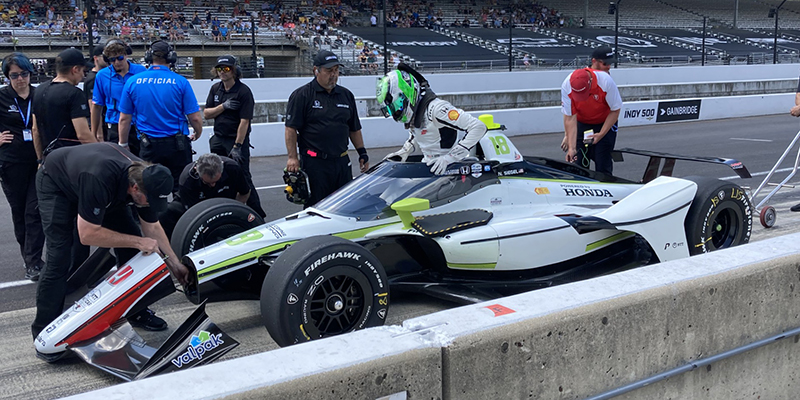
Like I have many times before, I watched Pole Day from Stand E with my family. With the Pole on the line, as well as the last three spots on the "500" grid, the day was primed to be full of drama. It lived up to the expectations.
Graham Rahal, trying to make the field after being bumped in 2023, once again found himself in the Last Chance Qualifying group, fighting for one of three vacant spots on the 11th and final row alongside 2022-winner Marcus Ericsson; Katherine Legge, attempting to make her fourth 500; and Siegel, an 18-year-old rookie.
As a fan, I can't recommend attending Pole Day enough. The access is incredible and the action is always compelling. While race day is great and an experience unlike any other, days like Pole Day also create life-long fans. One of my earliest memories of the speedway is sitting in the first turn, watching Greg Ray, Scott Sharp, and Billy Boat out on track, then walking by Gasoline Alley to see the cars getting pushed back to the garage. There's usually some time to kill, opportunities to walk around and absorb the grandeur of the speedway and the event.
One thing the Indianapolis 500 does particularly well, in my opinion, is providing ample opportunity for people to get to the track, whether you're a diehard who doesn't miss a session or a parent looking for a weekend activity for your kids. Half the battle is getting people in the door, and a low barrier of entry goes a long way.
Our entire afternoon at the speedway, we were surrounded by families. Some young, some old, but I can almost guarantee that when Alan Bestwick announced Scott McLaughlin's first lap of 234.5 mph on his eventual Pole run, many new fans were born. There are few moments in sports that equal the shock of a fast lap at IMS. The speed flashes on the screen, the public address announcer's booming voice echoes through the grandstands, drowned out by cheers, and the anticipation builds as the driver pushes the limit for three more laps.
It's a fun, entertaining, and simple day that is easy to follow along with for any new fan, thanks to the relatively simple task at hand: who can go faster?
But, as always at IMS, the highs must come with the lows.
Siegel, after being forced to a backup chassis, was never able to find the speed to secure a spot in the race, despite pulling with a fraction of a second of Rahal, the 33rd and final qualifier.
In a last-ditch effort to make the show, the 18-year-old left it all on the track, losing control of his Dale Coyne Racing Dallara in Turn One of his second lap. Once again, his day ended at the Infield Care Center, unhurt, aside from the pain of missing out on one of the biggest races in the world.
However, he did take some solace in the fact that he--and the team--did everything they could to make the field.
"We took a swing at it to try and find half of a mile per hour," Siegel said. "I was going to go home because I went flat and did everything I could do. I wasn't going to go home because I lifted."
Stay tuned for "Behind-the-Scenes: May in Indianapolis -- Part 2" which will include dispatches from motorsports events beyond the Brickyard, including USAC dirt and pavement action, memorabilia shows, a race shop grand opening, and more.
 MEMBERSHIP LOGIN
MEMBERSHIP LOGIN JOIN PRI
JOIN PRI
